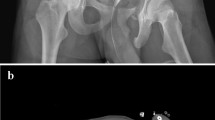Abstract
Introduction
Several different systems of classification have been developed to understand the complexity of pelvic ring fractures, to facilitate communication between physicians and to support the selection of appropriate therapeutic measures. The purpose of this study was to measure the inter- and intraobserver reliability of Tile AO, Young and Burgess, and FFP classification in pelvic ring fractures. The Rommens classification system (FFP) is analyzed for the first time.
Materials and methods
Four reviewers (2 × senior pelvic trauma surgeon, 1 × resident, 1 × medical student) separately analyzed and classified 154 CT scans of patients with pelvic fracture. The Tile AO, the Young and Burgess, and the FFP classifications (subgroup with patients ≥ 60 years) were compared. Another blinded re-evaluation was carried out after 2 months to determine intraobserver reliability.
Results
The overall interobserver agreement was fair for all classification systems (ICC: OTA 0.55, Young and Burgess 0.42, FFP 0.54). For specific categories, (e.g. type B or C fractures), there was a substantial agreement between the experienced surgeons (kappa: OTA 0.64, Young and Burgess 0.62, FFP 0.68). For inexperienced observers, there was a fair agreement in all systems (kappa: OTA 0.23, Young and Burgess 0.23, FFP 0.36).
Conclusions
All three classifications reach their maximum reliability with advanced expertise in the surgery of pelvic fractures. The novel FFP classification has proved to be at least equivalent when directly compared to the established systems. The FFP classification system showed substantial reliability in patients older than 60 years.
Similar content being viewed by others
References
Buller LT, Best MJ, Quinnan SM (2016) A nationwide analysis of pelvic ring fractures: incidence and trends in treatment, length of stay, and mortality. Geriatr Orthop Surg Rehabil 7:9–17. https://doi.org/10.1177/2151458515616250
Pereira GJC, Damasceno ER, Dinhane DI et al (2017) Epidemiology of pelvic ring fractures and injuries. Rev Bras Ortop 52:260–269. https://doi.org/10.1016/j.rboe.2017.05.012
Kannus P, Parkkari J, Niemi S, Sievänen H (2015) Low-trauma pelvic fractures in elderly finns in 1970–2013. Calcif Tissue Int 97:577–580. https://doi.org/10.1007/s00223-015-0056-8
Krappinger D, Kammerlander C, Hak DJ, Blauth M (2010) Low-energy osteoporotic pelvic fractures. Arch Orthop Trauma Surg 130:1167–1175. https://doi.org/10.1007/s00402-010-1108-1
Studer P, Suhm N, Zappe B et al (2013) Pubic rami fractures in the elderly–a neglected injury? Swiss Med Wkly 143:w13859. https://doi.org/10.4414/smw.2013.13859
Taillandier J, Langue F, Alemanni M, Taillandier-Heriche E (2003) Mortality and functional outcomes of pelvic insufficiency fractures in older patients. Jt Bone Spine 70:287–289
Yang N-P, Chan C-L, Chu D et al (2014) Epidemiology of hospitalized traumatic pelvic fractures and their combined injuries in Taiwan: 2000–2011 National Health Insurance data surveillance. Biomed Res Int 2014:878601. https://doi.org/10.1155/2014/878601
Tile M (1996) Acute pelvic fractures: I. causation and classification. J Am Acad Orthop Surg 4:143–151
Marsh JL, Slongo TF, Agel J et al Fracture and dislocation classification compendium—2007: orthopaedic trauma association classification, database and outcomes committee. J Orthop Trauma 21:S1-133
Young JW, Burgess AR, Brumback RJ, Poka A (1986) Pelvic fractures: value of plain radiography in early assessment and management. Radiology 160:445–451. https://doi.org/10.1148/radiology.160.2.3726125
Rommens PM, Hofmann A (2013) Comprehensive classification of fragility fractures of the pelvic ring: recommendations for surgical treatment. Injury 44:1733–1744. https://doi.org/10.1016/j.injury.2013.06.023
Gabbe BJ, Esser M, Bucknill A et al (2013) The imaging and classification of severe pelvic ring fractures: experiences from two level 1 trauma centres. Bone Jt J 95–B:1396–1401. https://doi.org/10.1302/0301-620X.95B10.32134
Furey AJ, O’Toole RV, Nascone JW et al (2009) Classification of pelvic fractures: analysis of inter- and intraobserver variability using the Young–Burgess and tile classification systems. Orthopedics 32:401. https://doi.org/10.3928/01477447-20090511-05
Koo H, Leveridge M, Thompson C et al (2008) Interobserver reliability of the young–burgess and tile classification systems for fractures of the pelvic ring. J Orthop Trauma 22:379–384. https://doi.org/10.1097/BOT.0b013e31817440cf
Cohen J (1960) A coefficient of agreement for nominal scales. Educ Psychol Meas 20:37–46. https://doi.org/10.1177/001316446002000104
Landis JR, Koch GG (1977) The measurement of observer agreement for categorical data. Biometrics 33:159–174
Shrout PE, Fleiss JL (1979) Intraclass correlations: uses in assessing rater reliability. Psychol Bull 86:420–428
Cicchetti DV, Sparrow SA (1981) Developing criteria for establishing interrater reliability of specific items: applications to assessment of adaptive behavior. Am J Ment Defic 86:127–137
Funding
There is no funding source.
Author information
Authors and Affiliations
Corresponding author
Ethics declarations
Conflict of interest
The authors declare that they have no conflict of interest.
Ethical approval
All procedures involving human participants were in accordance with the ethical standards of the institutional and national research committee (reference number: WF-009/18) and with the 1964 Helsinki declaration and its later amendments or comparable ethical standards.
Additional information
Publisher’s Note
Springer Nature remains neutral with regard to jurisdictional claims in published maps and institutional affiliations.
Electronic supplementary material
Below is the link to the electronic supplementary material.
Rights and permissions
About this article
Cite this article
Berger-Groch, J., Thiesen, D.M., Grossterlinden, L.G. et al. The intra- and interobserver reliability of the Tile AO, the Young and Burgess, and FFP classifications in pelvic trauma. Arch Orthop Trauma Surg 139, 645–650 (2019). https://doi.org/10.1007/s00402-019-03123-9
Received:
Published:
Issue Date:
DOI: https://doi.org/10.1007/s00402-019-03123-9




